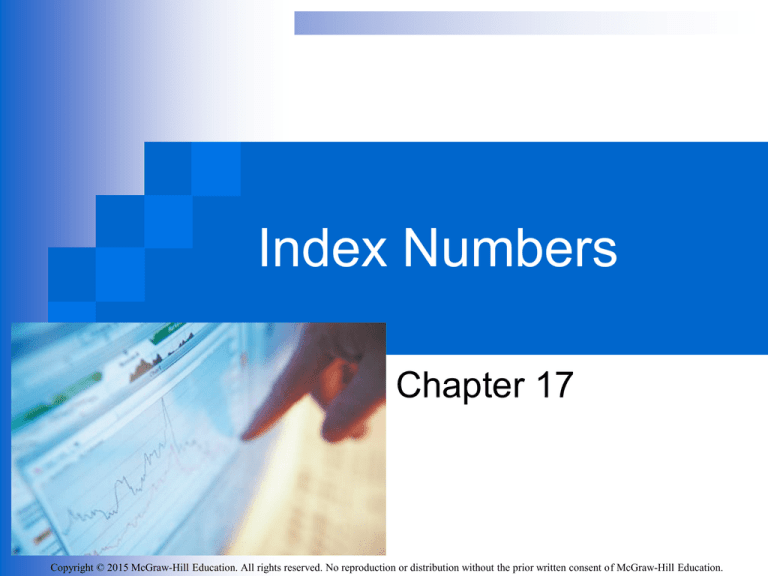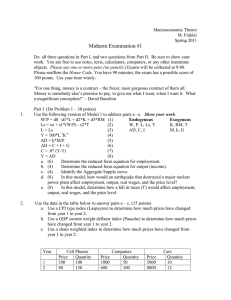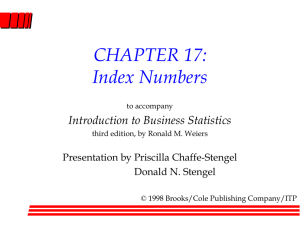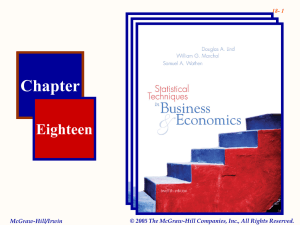
Index Numbers
Chapter 17
Copyright © 2015 McGraw-Hill Education. All rights reserved. No reproduction or distribution without the prior written consent of McGraw-Hill Education.
Learning Objectives
LO17-1 Compute and interpret a simple,
unweighted index.
LO17-2 Compute and interpret an unweighted
aggregate index.
LO17-3 Compute and interpret a weighted
aggregate index.
LO17-4 List and describe special-purpose
indexes.
LO17-5 Apply the Consumer Price Index.
17-2
Index Numbers
LO17-1 Compute and interpret
a simple, unweighted index.
INDEX NUMBER An index number can also be
used to compare two numbers. A number that
measures the relative change in price, quantity,
value, or some other item of interest from one time
period to another.
SIMPLE INDEX NUMBER compares two numbers,
or measures the relative change in just one variable
over time.
17-3
LO17-1
Simple Index Number – Example 1
An index number can also compare one item with
another.
Example: The population of the Canadian province of
British Columbia in 2013 was 4,494,232 and for Ontario
it was 13,069,182. What is the population of British
Columbia compared to Ontario?
P
Population of British Columbia
4,494,232
X100
X100 34.4
Population of Ontario
13,069,182
Interpretation: The population of British Columbia is
34.4 % of the population of Ontario.
17-4
LO17-1
Simple Index Number – Example 2
The following chart shows the number of passengers (in millions) for the ten
busiest airports in the United States in 2011. What is the index for the other
airports compared to Houston?
92.3/40.1 =230.2
40.8/40.1=101.
7
Interpretation: The Atlanta airport is 2.302 times as busy as the Houston
airport. The San Francisco airport is only 1.017 times as busy as the
Houston airport.
17-5
LO17-1
Simple Index Number – Example 3
According to the Bureau of Labor Statistics, in 2005 the
average hourly earnings of production workers was
$14.02. In 2014 it was $18.62. What is the index of
hourly earnings of production workers for 2014 based
on 2005 data?
Average hourly earnings in 2014
$18.62
P=
X100 =
X100 = 132.81
Average hourly earnings in 2005
$14.02
Interpretation: Average hourly earnings in 2014 are
1.3281 times more than they were in 2005, or average
hourly earnings in 2014 have increased 32.81% since
2005.
17-6
LO17-2 Compute and interpret
an unweighted aggregate index.
Unweighted Aggregate Indexes
In many situations we wish to combine several items and develop an
index to compare the cost of this aggregation of items in two
different time periods.
For example, we might be interested in the expense of
operating and maintaining an automobile. For the index, it
might include tires, oil changes, and gasoline prices.
Or we might be interested in a college student index. This
index might include the cost of books, tuition, housing, meals,
and entertainment.
There are several ways to combine the items to determine an index.
Each has its advantages and disadvantages based on the variables
used to compute the index.
17-7
LO17-2
Unweighted Aggregate Indexes
where Pi refers to the simple index for each of the items and n
the number of items.
Interpretation: On average the price of the six items increased
52.2% from 2003 to 2013.
17-8
LO17-2
Unweighted Aggregate Indexes
Where ∑pt is the sum of the prices (rather than the indexes) for the
period t and ∑p0 is the sum of the prices for the base period, 0.
Interpretation: Based on this way to aggregate or combine the
data, the price of the six items increased 56.1% from 2003 to 2013.
17-9
LO17-3 Compute and interpret
a weighted aggregate index.
Weighted Aggregate Index:
Laspeyres Index
Note that the prices of each item are weighted by the quantities
consumed in the base period. Then these weighted prices are
summed over all the items in each period to calculate a
weighted aggregate index.
Advantages Requires quantity data from only the base period. This
allows a more meaningful comparison over time. The changes in
the index can be attributed to changes in the price.
Disadvantages Does not reflect changes in buying patterns over
time. Also, it may overweight goods whose prices increase.
17-10
LO17-3
Weighted Aggregate Index:
Laspeyres Index- Example
17-11
LO17-3
Weighted Aggregate Index:
Laspeyres Index- Example
Interpretation: Based on this Laspeyres method to aggregate and
weight the price data, the price of the six items increased 40.28% from
2003 to 2013.
17-12
LO17-3
Weighted Aggregate Index:
Paasche Index
Note that the prices of each item are weighted by the quantities consumed in the current
period, t. Then these weighted prices are summed over all the items in each period to
calculate a weighted aggregate index.
Advantages Because it uses quantities from the current period, it reflects current
consumption habits.
Disadvantages It requires quantity data for the current year. Because different
quantities are used each year, it is impossible to attribute changes in the index to
changes in price alone. It tends to overweight the goods whose prices have declined
(assumes the classic economics relationship between price and demand).
17-13
LO17-3
Weighted Aggregate Index:
Paasche Index- Example
Interpretation: Based on the Paasche method to weight and aggregate the
price data, the price of the six items increased 38.9% from 2003 to 2013.
17-14
LO17-3
Weighted Aggregate Index:
Fisher’s Ideal Index
Laspeyres’ index tends to overweight goods whose
prices have increased. Paasche’s index, on the other
hand, tends to overweight goods whose prices have
gone down.
Fisher’s ideal index was developed in an attempt
to offset these shortcomings.
It is the geometric mean of the Laspeyres and
Paasche indexes.
17-15
LO17-3
Weighted Aggregate Index:
Fisher’s Ideal Index- Example
Interpretation: Based on Fisher’s ideal method to combine the Laspeyres and
Paasche indexes, the price of the six items increased 39.6% from 2003 to 2013.
17-16
LO17-3
Weighted Aggregate Index:
Value Index
A value index measures changes in both the price and
quantities involved.
17-17
LO17-3
Weighted Aggregate Index:
Value Index- Example
The prices and quantities sold at the Waleska Clothing Emporium
for various items of apparel for May 2000 and May 2014 are:
What is the index of value for May 2009 using May 2014 as the base period?
17-18
LO17-3
Weighted Aggregate Index:
Value Index- Example
Interpretation: Based on the Value Index, the price of men's clothing
increased 17.8% from 2000 to 2014.
17-19
LO17-4 List and describe
special-purpose indexes.
Special Purpose Indexes:
Consumer Price Index
The U.S. Bureau of Labor
Statistics reports this index
monthly. It describes the
changes in prices from one
period to another for a
“market basket” of goods
and services.
An Interpretation: For example, the annual CPI for 2012 was 229.594.
This means that consumer prices are 2.29594 times higher than the base
period of 1982-1984.
17-20
LO17-4
Special Purpose Indexes:
Producers Price Index
Formerly
called
the
Wholesale Price Index, it
dates back to 1890 and is
also published by the U.S.
Bureau of Labor Statistics.
It reflects the prices of over
3,400 commodities. Price
data are collected from the
sellers of the commodities,
and it usually refers to the
first
large-volume
transaction
for
each
commodity.
It
is
a
Laspeyres-type index.
17-21
LO17-4
Special Purpose Indexes:
Dow Jones Industrial Average (DJIA)
DJIA is an index of stock prices, but
perhaps it would be better to say it is
an “indicator” rather than an index.
It is supposed to be the mean price of
30 specific industrial stocks.
However, summing the 30 stock prices
and dividing by 30 does not calculate
its value. This is because of stock
splits, mergers, and stocks being
added or dropped.
When changes occur, adjustments are
made in the denominator used with the
average.
17-22
LO17-5 Apply the
Consumer Price Index.
The Consumer Price Index (CPI)
It allows consumers to determine the effect of price
increases on their purchasing power.
It is a yardstick for revising wages, pensions, alimony
payments, etc.
It is an economic indicator of the rate of inflation in the
United States.
It can be used to compute real income:
real income = money income/CPI X (100)
The CPI can be used to:
determine real disposable personal income,
deflate sales or other variables,
find the purchasing power of the dollar.
17-23
LO17-5
CPI and Real Income: Example
Computing Real Income: We can compare monetary
values from two different time periods and use the CPI
to remove the effects of inflation.
Interpretation: Annual income increased, but the
increase was totally accounted for by inflation.
The person’s purchasing power did not increase.
17-24
LO17-5
CPI as a Deflator: Example
A price index, such as the CPI or the Producer Price
Index (PPI), can also be used to “deflate” sales or similar
money series. Deflated sales are determined by:
Interpretation: Total corporate sales may appear to be
increasing, However, when adjusted for inflation using
the PPI, the “constant dollars” have actually decreased.
17-25
LO17-5
CPI and Real Income: Example
The Consumer Price Index is also used to determine the
purchasing power of the dollar.
Suppose the Consumer Price Index this month is 200.0. What is
the purchasing power of the dollar relative to the base period of
1982-84?
Interpretation: The purchasing power of a dollar is half
compared to the average value in 1982-1984.
17-26








